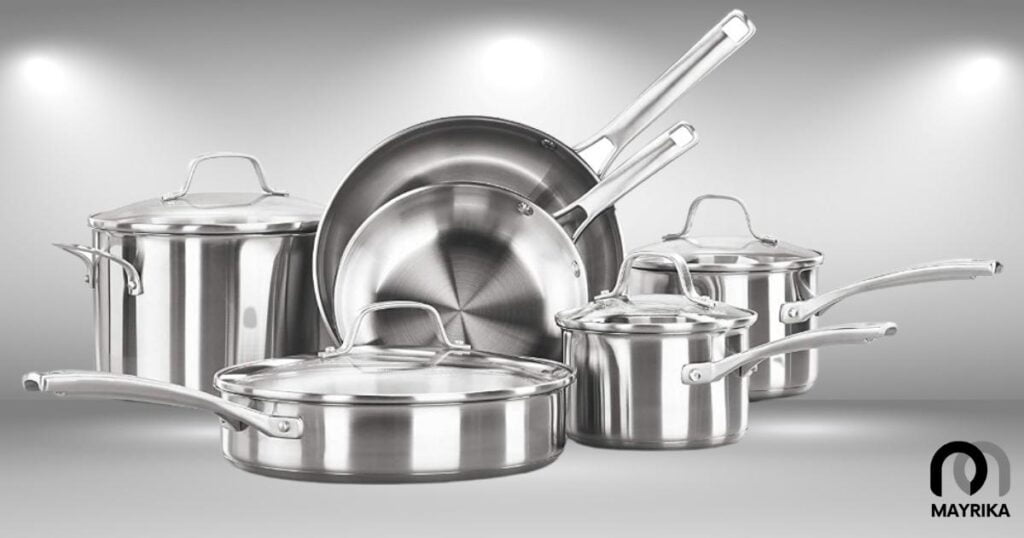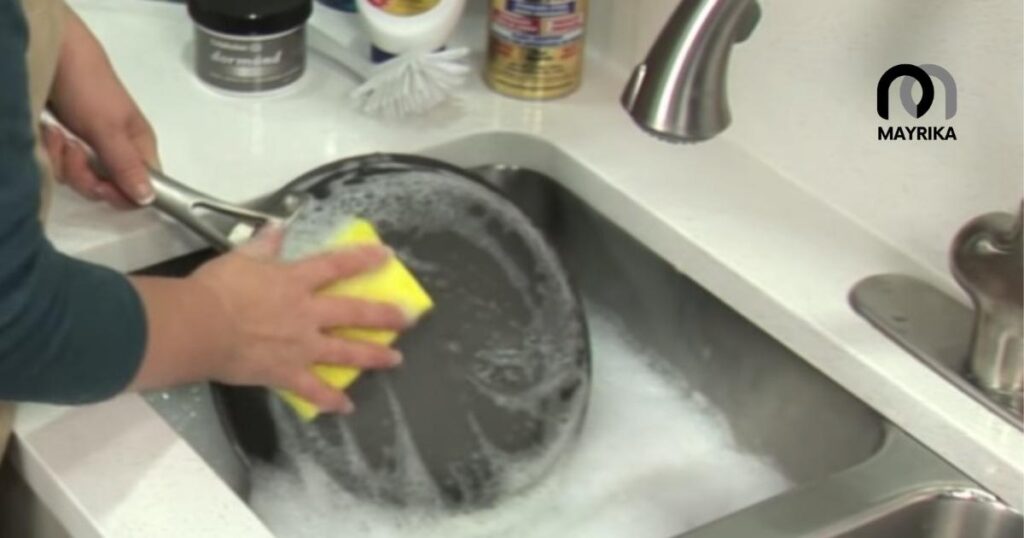If you’re like most people, you’ve accumulated a few pieces of cookware over the years.
Maybe you’ve been using the same pots and pans for years, or you inherited cookware from a family member.
But eventually, these pots and pans start to wear down – the coating on the inside starts to come off, and the metal starts to rust.
If you don’t take care of your cookware, it can become unusable and even dangerous.
In this article, we’ll show you how to clean old Calphalon cookware safely and properly.
Calphalon Cookware
Calphalon cookware is a kitchen staple for many home cooks and professional chefs.
The cookware is known for its durability, even heat distribution, and non-stick properties.
Whether you’re looking for a Calphalon pan to fry up some eggs or a pot to simmer a sauce, there’s a piece of Calphalon cookware that will suit your needs.
While Calphalon cookware is generally very reliable, it’s not indestructible.
If you use your pans and pots on high heat or abuse them in other ways, they will eventually show signs of wear and tear.
With proper care and cleaning, however, your Calphalon cookware can last for many years.

How To Clean Old Calphalon Cookware
If your Calphalon cookware is starting to look a bit old and stained, there are a few simple ways to clean it and make it look new again.
First, if there is any burnt-on food or grease, you can soak the pan in hot soapy water for a few hours to loosen it.
For tougher stains, you can use a non-abrasive cleaner like Bon Ami or Bar Keepers Friend.
Just apply the cleaner to the wet pan, scrub with a non-abrasive sponge, and rinse clean.
If your pan is still not looking as good as new, you can try polishing it with a little bit of cooking oil.
Just rub a small amount of oil into the pan with a clean cloth, then buff it until it shines.
How Do You Clean A Nonstick Calphalon?
It is important to know how to properly clean a nonstick Calphalon in order to keep the coating intact and functioning.
The first thing to avoid is using any metal utensils as they can scratch the surface. Instead, use wooden or nylon cooking tools.
To clean the pan, simply use hot soapy water and a sponge or nonabrasive cloth.
Avoid using harsh cleansers or scrubbers as they can also damage the nonstick coating.
If there are any stuck-on bits of food, you can gently scrape them off with a plastic putty knife.
Once the pan is clean, rinse it with hot water and dry it with a soft towel.
Cleaning Calphalon Anodized Cookware
If your Calphalon anodized cookware is starting to look a little stained and dirty, don’t worry – it’s easy to get it clean with just a few simple steps.
First, start by washing your pan in warm, soapy water. Rinse it well and then dry it thoroughly with a soft cloth.
If there are any stubborn spots, you can use a non-abrasive cleaner like Bon Ami or Bar Keepers Friend.
Just make sure to rinse the pan afterward and dry it completely.
Once your pan is clean, it’s important to protect the anodized finish. The best way to do this is to use cooking spray or oil before cooking.
This will help create a barrier between the food and the pan, making cleanup much easier.

How Do You Clean A Burnt Calphalon Stainless Steel Pan?
If you’ve ever cooked with stainless steel, you know that it’s one of the most durable materials around.
But even the best cookware can suffer from burnt-on food and grease.
Here’s how to get your Calphalon Stainless steel pan clean and looking like new again.
The first step is to fill your pan with hot water and a little dish soap. Let it soak for about 20 minutes to loosen the burnt-on food.
Next, use a non-abrasive scrubber to gently remove the food from the pan.
If you’re having trouble getting all the food off, you can try using a little vinegar or baking soda.
Once the burnt-on food is gone, rinse your pan with hot water and dry it well.
Your Calphalon Stainless steel pan should now be clean and look like new!
How To Clean Calphalon Cast Iron Skillet
Cast iron skillets are versatile and durable kitchen tools that can last for years with proper care.
While they are built to withstand high heat cooking, they can be delicate and require some special cleaning care to keep them looking their best.
Here are some tips on how to clean your Calphalon cast iron skillet.
Start by heating the skillet on the stovetop over medium heat for about 10 minutes.
This will help loosen any stuck-on food particles. Next, add a little water to the skillet and use a stiff brush to scrub away any remaining food debris.
Rinse the skillet well and dry it completely with a clean towel.
If your skillet is still not looking as good as new, you can try using a mild abrasive cleaner like Bar Keepers Friend or Bon Ami.
These cleaners will remove any stubborn stains without damaging the seasoning on your skillet.
Cleaning Calphalon Ceramic Pans
If you’re looking for tips on how to clean your Calphalon ceramic pans, you’ve come to the right place.
Here are three easy methods that will get your pans sparkling clean in no time.
Method 1: Baking Soda and Vinegar
Start by mixing together equal parts baking soda and vinegar. Add just enough water to make a paste, then spread it evenly over the surface of the pan.
Let it sit for 10-15 minutes, then scrub with a non-abrasive sponge or brush. Rinse well and dry with a soft cloth.
Method 2: Dish soap and Baking Soda
Another option is to mix together dish soap and baking soda. Wet the pan, then sprinkle on the baking soda.
Rub it in with a sponge or brush, then rinse thoroughly and dry.
How To Clean The Bottom Of Calphalon Pans
If you’re like most people, you probably use your Calphalon pans on a daily basis.
Over time, the bottom of these pans can become stained and difficult to clean.
Here are a few tips on how to clean the bottom of your Calphalon pans so that they look new again.
One of the easiest ways to clean the bottom of your Calphalon pans is to soak them in hot, soapy water for a few minutes.
This will help loosen any stubborn dirt or grime that may be stuck to the bottom of the pan.
After soaking, simply scrub the bottom of the pan with a sponge or brush to remove any remaining dirt.
If your pans are particularly dirty, you may need to use a harsher cleaning agent such as vinegar or baking soda.
What Can You Do With Old Calphalon Pans?
When it comes to old Calphalon pans, there are a few things you can do. You can donate them, recycle them or even upcycle them.
Donating your old Calphalon pans is a great way to give back to the community.
There are many organizations that accept donations of gently used cookware.
This is a great option if your pans are still in good condition but you no longer have a use for them.
Recycling your old Calphalon pans is another great option. Most recycling centers will accept metal cookware.
This is a good option if your pans are no longer in good condition and you want to make sure they are properly disposed of.
Upcycling your old Calphalon pans are a great way to get creative and make something new out of something old.
What Are The Best Ways To Prevent Your Calphalon Cookware From Sticking?
If you’re one of the many people who own Calphalon cookware, you know that it’s important to keep it clean and well-maintained.
But what about when your Calphalon starts to stick?
Here are some tips on how to prevent your Calphalon from sticking:
- Season your pan before use. This will create a natural nonstick surface.
- Use oil or butter when cooking. This will help to create a barrier between the food and the pan.
- Avoid using cooking sprays, as they can cause the pan to become sticky over time.
- Make sure your pan is heated properly before adding food. This will help to prevent sticking and ensure even cooking.
- Avoid using metal utensils on the nonstick surface.
- Use a soft scraper to remove stuck-on food instead of harsh abrasives, which will damage the coating and make it more likely to stick in the future.
FAQs
When should you throw away Calphalon pans?
Calphalon is a trusted name in cookware, but even the best pans have a lifespan.
When should you say goodbye to your beloved Calphalon pots and pans?
After about 10 years: If you’ve had your Calphalon cookware for 10 years or more, it’s probably time to start thinking about replacing it.
The nonstick coating may be worn down, making it less effective and more difficult to clean. The metal may also be warped or discolored.
If you see the damage: If your Calphalon pans are scratched, dented, or otherwise damaged, it’s time to get rid of them.
Damaged cookware can be dangerous, as the damage can create hot spots that can burn food.
How do you make Calphalon pans non-stick again?
If your Calphalon pans are starting to lose their non-stick properties, there are a few things you can do to make them non-stick again.
First, try scrubbing the pans with a non-abrasive sponge and soapy water.
If that doesn’t work, you can try using a mild abrasive, like baking soda or salt, to scrub the pan.
If those methods don’t work, you can try heating the pan on high for a few minutes and then adding oil to the pan and scrubbing it with a paper towel.
Are old Calphalon pans safe?
If you have an old Calphalon pan, you may be wondering if it is safe to use.
The short answer is that yes, old Calphalon pans are safe to use.
However, there are a few things to keep in mind. First, make sure that the pan is not damaged.
If there are any cracks or chips on the surface of the pan, it is best to throw it out and get a new one.
Old Calphalon pans that are in good condition can last for many years.
Second, when using an old Calphalon pan, be sure to use low or moderate heat.
High heat can cause the pan to warp or even break.
Finally, if you take good care of your old Calphalon pan, it will last even longer.
Can I use Bar Keepers Friend on Calphalon?
If you’re wondering whether you can use Bar Keepers Friend on Calphalon, the answer is yes!
This cleaner is perfect for getting rid of tough stains and buildup on your cookware.
Here’s how to use it:
First, wet the surface of your cookware with warm water.
Then, sprinkle Bar Keepers Friend onto the surface and scrub with a sponge or brush.
Rinse the cookware well and dry it with a clean towel.
You’ll be amazed at how well this cleaner works – your Calphalon will look like new again!
Does Calphalon coating come off?
Calphalon is a type of cookware that is coated with a non-stick material.
This coating helps to prevent food from sticking to the surface of the pan and makes cleanup easier.
However, some users have reported that the coating on their Calphalon pans has begun to come off.
There are a few possible reasons why this may happen.
First, it is important to make sure that you are using the proper cooking utensils with your Calphalon pans.
Metal utensils can scratch the surface of the pan and cause the coating to come off.
Second, make sure that you are not overusing or abusing your pans.
Over time, constant use and exposure to high temperatures can cause the non-stick coating to break down.
If you take proper care of your Calphalon cookware, it should last for many years.
Final Remarks
In conclusion, cleaning old Calphalon cookware is not as difficult as it may seem.
With a little elbow grease and the right cleaners, your cookware can look like new again.
So don’t be afraid to break out the scrub brush and get to work!
